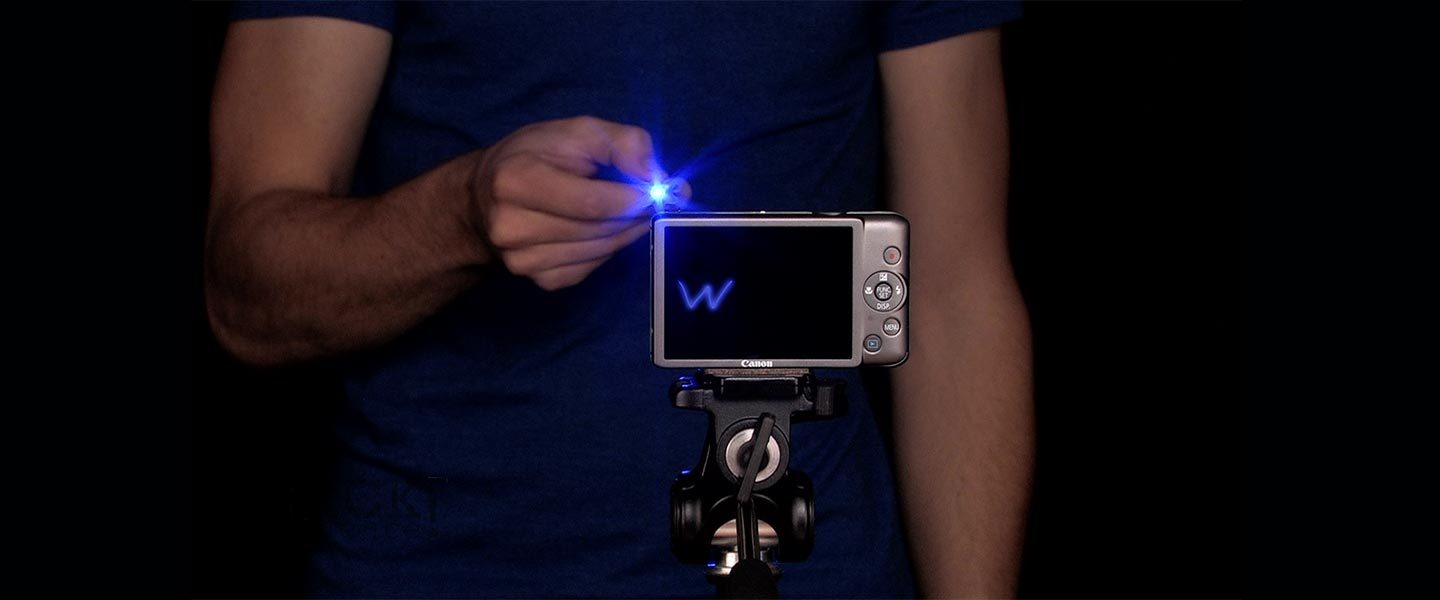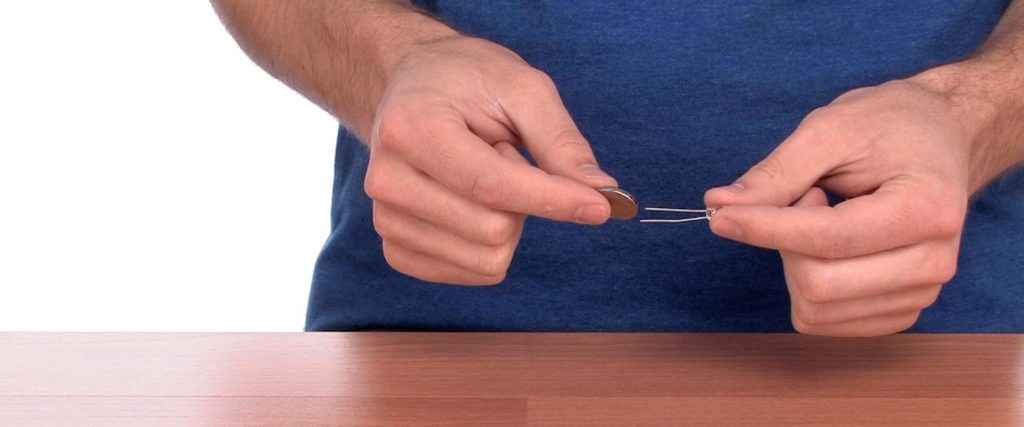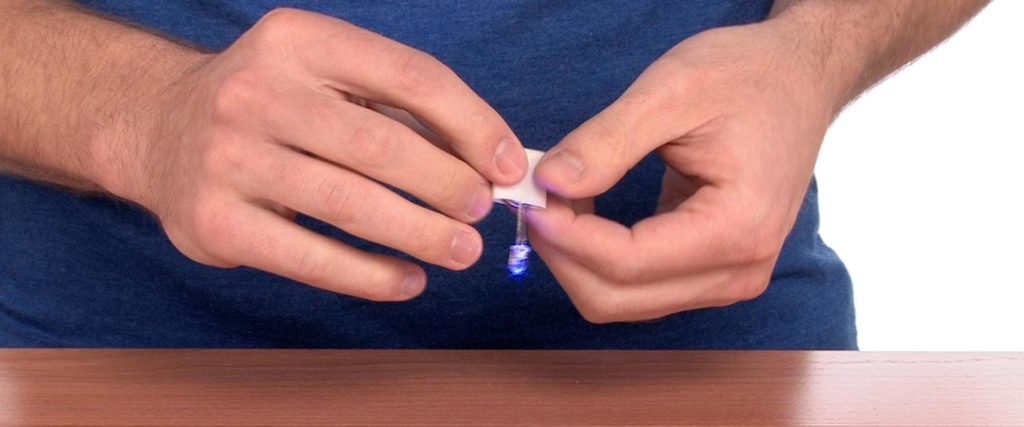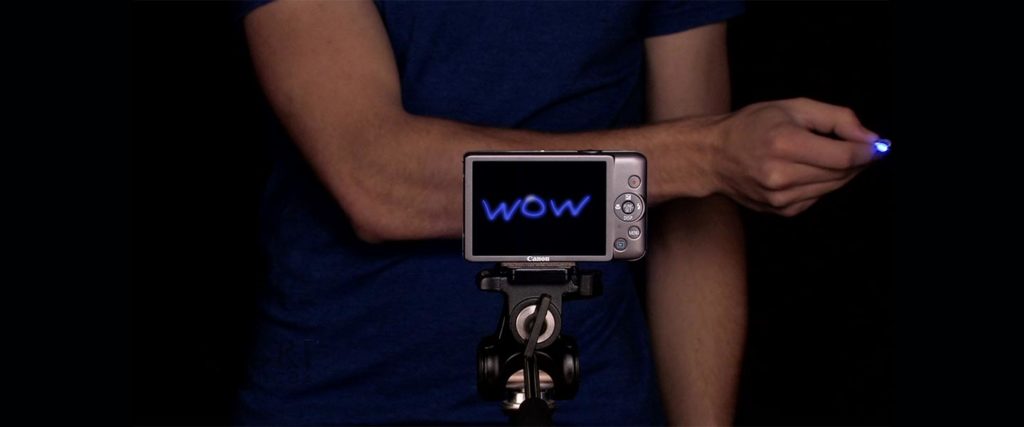Black Light Secret Message
Highlighters have a number of uses, from helping acknowledge important text to acting as brightly-colored markers in our favorite coloring book. Around Halloween, though, we’ve […]

Writing in the dark is challenging. After a letter or two, it gets messy and the message is lost. Even something as simple as your name will look like you were writing in an earthquake. It’s especially tough when you have to write backwards and you can’t see the letters. It takes a combination of steady hands, backwards thinking, and technology to get to a phenomenal writing experience.

If you haven’t already, take a close look at the legs on the LED. Notice that one leg is slightly longer than the other. That’s not a manufacturing goof; that’s on purpose. Slide the longer leg of the LED onto the positive (+) pole of the button battery, pinch the legs against the battery, and… it lights! (This is called a “sanity check” to be sure that everything is working fine.)

Tape the legs of the lighted LED to the button battery. This will be your pen.
Place a digital camera on a solid footing (a tripod is perfect but optional). Set it to either a very slow shutter speed or to an option that gives you an open shutter. Darken the room as much as you can.

Make sure the LED is pointed toward the camera and write a simple message in the air like: HI, WOW!, MOM, DAD, FUN, etc. Remember to write the letters from right to left and backwards so they can be read on the camera screen. You may be onto a new form of communication!
The keys to writing a message are in the camera settings and writing with a steady hand. The shutter on the camera is what allows light into it to make a picture. When it’s open, light can pass through the lens. At a regular speed or exposure time, the shutter allows light into the camera for a fraction of a second measured in the thousandths of a second. When you adjust the shutter to a s-l-o-w closing speed (or for a long exposure), you allow the shutter to remain open and let in light continuously until it closes. With a longer exposure time, the open shutter allows the camera to collect light during the entire time you are writing a message.
An LED glows only if its legs are positioned a certain way. Test this by placing the longer leg of an LED on the negative (–) pole of the battery… nothing happens. Electrons “flee” from a negative charge and flow to a positive charge. You can guess that in a circuit, then, the flow is the same way: from negative to positive. An LED will light up only when the current is flowing in the right direction. The longer leg of an LED must be toward the positive pole of the power source if you want the LED to work.
When a device will function only with a certain direction of electron flow (like an LED), it’s said to be a “polar” device (because of the “poles” on a battery). The “polarity” of the device has to be in the correct order for it to work properly.
LEDs are everywhere in phones, cars, and even homes. Anytime something electronic lights up, there’s a good chance an LED is involved. They come in a huge variety of sizes, shapes, and colors, too.
LEDs are a particular type of diode that convert electrical energy into light energy. In fact, LED stands for “Light Emitting Diode.” LEDs are sort of like tiny conventional lightbulbs, but require a lot less power. They’re also more energy efficient, so they tend not to get hot like conventional lightbulbs. This makes LEDs ideal for mobile devices and other low-power applications. High-intensity LEDs are now being used in accent lighting, spotlights, flashlights, and even automotive headlights.
The luminous intensity of LEDs can range from just tens up to tens-of-thousands of millicandela (mcd). The “power on/off” light on a TV is probably about 100 mcd, whereas a good flashlight might be 20,000 mcd. FYI: Looking straight into anything brighter than a few thousand millicandela can be painful and should be avoided.